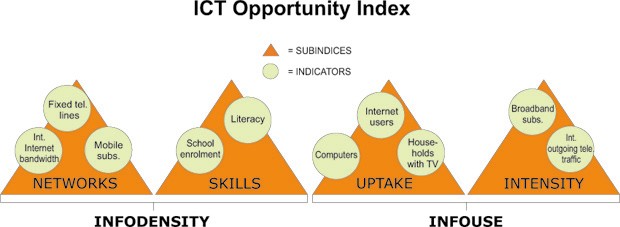
The 2007 ICT-OI, which is an inclusive index and provides measurement across 183 economies, relies on ten indicators that help measure ICT networks, education and skills, uptake and intensity of the use of ICT (Figure 1). For analytical purposes, economies are grouped into four categories, ranging from high to low ICT Opportunities. Apart from cross-country comparisons, the index’s methodology highlights relative movements between 2001-2005. A comparison of annual average growth rates shows which countries are making progress and how fast.
The 2007 ICT-OI results showed that significant progress has been made across almost all economies and all areas of the telecommunication/ ICT sector since the beginning of this century. At the same time, major differences remain. Countries with low ICT Opportunity levels are heavily concentrated in Africa, with some Asian countries in this category represented as well. From the Americas, Haiti, Cuba, Honduras and Nicaragua also have low ICT-OI levels. Many of the countries with the highest growth rates (between 2001 and 2005) are Least Developed Countries (LDCs). While this is a positive development, growth rates need to be seen in perspective since high growth rates are not necessarily sufficient to overcome the digital divide, particularly in countries that start at very low ICT levels. It is also true that not all developing countries have high growth rates and the list of the countries with the lowest growth rates includes some LDCs.
The ICT-OI highlights that between 2001-2005 the divide increased between those economies that already have very high ICT levels and the rest of the world. It decreased between the medium group and the low group, indicating that countries with low levels of ICT have somewhat been able to catch up and reduce the divide compared to countries in the medium level.
An indicator-centric analysis suggests that the majority of countries are lagging behind in terms of broadband uptake and the difference in broadband penetration between economies with high ICT-OI levels and the rest of the world is significant and greater than for any other indicator. For policy makers, this finding suggests that more efforts need to be undertaken to integrate and strengthen broadband policies and strategies.
The 2007 ICT-OI, which is the result of the merger of the ITU’s Digital Access Index (DAI) and Orbicom’s Monitoring the Digital Divide/Infostate conceptual framework has been modified since it was last published in 2005. It is an excellent example for successful international cooperation and partnership work and follows the explicit recommendation of the WSIS Plan of Action, paragraph 28, to “…develop and launch a composite ICT Development (Digital Opportunity) Index” to combine statistical indicators with analytical work on policies and their implementation.